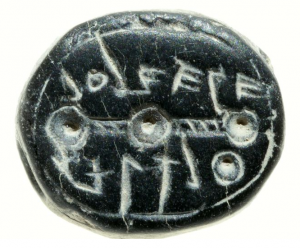
Israel Antiquities Authority admits “Finding seals that bear names from the time of the 1st Temple is hardly a commonplace occurrence, & finding a seal that belonged to a woman is an even rarer phenomenon.”
Who was Elihana bat Gael?
An exceptional woman during Jerusalem’s First Temple period, some 2,500 years ago, according to the Israel Antiquities Authority (IAA).
A view from the Jerusalem excavation site in the City of David
A rare seal bearing her name was recently unearthed in a large ancient building during excavations carried out in the Giv’ati parking lot at the City of David, in the Jerusalem Walls National Park, the IAA announced on Sunday.
Inscribed in ancient Hebrew letters on the seal, made of semi-precious stone, appears the mirror-writing of “to Elihana bat Gael,” along with the name of her father.
Another seal, belonging to a man named “Sa’aryahu ben Shabenyahu,” was found nearby.
The second seal exposed in the excavation was also in mirror-writing, and bears the inscription “to Sa’aryahu ben Shabenyahu.” The name Sa’aryahu appears on a sherd from Arad, and apparently means “the Lord, which was revealed in a storm” (Job 38).
“Finding seals that bear names from the time of the First Temple is hardly a commonplace occurrence, and finding a seal that belonged to a woman is an even rarer phenomenon,” said the IAA on Monday.
Indeed, according to the IAA’s excavation directors, “the owner of the seal was notable compared to other women of the First Temple period: She had legal status, which allowed her to conduct business and possess property.”
The rare bounty was discovered inside a structure built of well-preserved ashlars following nine years of excavating at the site outside the Old City’s Walls by the IAA, in cooperation with the Nature and Parks Authority and the City of David Foundation.
The Authority’s excavation directors Dr. Doron Ben-Ami, Yana Tchekhanovets and Salome Cohen said they believe that the ancient building once served as an administrative center.
“Personal seals, such as those of Elihana and Sa’aryahu, were used for signing documents, and were frequently inlaid as part of a ring that was worn by the owner,” the archaeologists said in a joint statement.
“In antiquity, they designated the identity, genealogy and status of the owner of the seal.”
According to Dr. Hagai Misgav of Hebrew University in Jerusalem, seals that belonged to women represent a very small proportion of all the seals that have been discovered to date.
“This is because of the generally inferior economic status of women, apart from extraordinary instances such as this,” said Misgav.

The rare seal belonging to a woman during the First Temple Period bearing the inscription: “To Elihana bat Gael” – Photo courtesy: CLARA AMIT/ISRAEL ANTIQUITIES AUTHORITY
“Indeed, the name Elihana does not appear in the Bible, and there is no other information regarding the identity of the woman, but the fact that she possessed a seal demonstrates her high social status.”
Misgav noted that most of the women’s seals known from this period bear the names of their fathers, rather than that of their husbands.
“Here, as in other cases, this might indicate the relatively elevated status of Elihana, which depended on her original family, and not on her husband’s family,” the researcher opined.
“It seems that Elihana maintained her right to property and financial independence, even after her marriage, and therefore her father’s name was retained. However, we do not have sufficient information about the law in Judah during this period.”
Misgav said the name Eliha is known from a contemporary Ammonite seal, and is the feminine form of the name Eli, known from the Bible.
“The script appearing on the seal is remarkably similar to the script on Ammonite seals, and this might indicate the foreign origin of the artisan who carved the seal, and possibly the foreign origin of Elihana, who apparently came from east of the Jordan River,” he said.
Misgav added that the Book of Proverbs (31:13-23) states that an ideal wife is responsible for providing for the needs of her household when her husband is engaged in public and legal affairs at the city gate.
“She seeks wool and flax, and works with willing hands…,” it says. “Her husband is known in the gates, when he sits among the elders of the land.”
“An archive of documents preserved in the Judean Desert from the time of the Second Temple indicates, among other things, the business of Babatha bat Shimon, a female land owner who had legal status,” said Misgav.
“But generally speaking, evidence of legal and financial independence in the Bible and archaeology are rare, and it seems that the exception to the rule indeed sheds light on the rule itself.”
View original The Jerusalem Post publication at:
http://www.jpost.com/Israel-News/Rare-2500-year-old-womans-seal-from-First-Temple-period-unearthed-in-Jerusalem-447113







 Israeli New Shekel Exchange Rate
Israeli New Shekel Exchange Rate